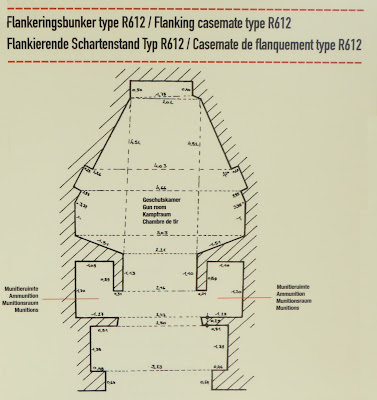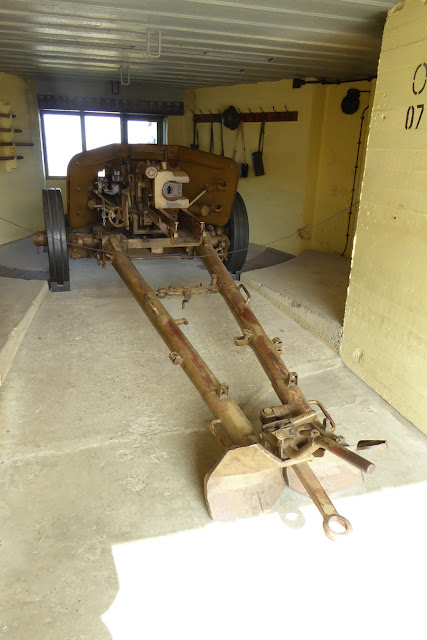 |
| Raversyde - Battery Saltzweddel Neu IJ / DM |
To consolidate their gains, the Kreigsmarine began the construction of a coastal battery in Summer 1941 to protect the port of Ostend. The first armaments installed were captured Belgian 120mm guns which were re-designated 12 cm K 370 (b). The guns fired a 22kg (48 pound) shell up to a range of 17.5 km (11 miles).
The gun emplacements were open platforms.
 |
| Raversyde - Battery Saltzweddel Neu Captured Belgian 120mm guns 12 cm K 370 (b). |
 |
| Raversyde - Battery Saltzweddel Neu |
 |
| Inspection of Captured Belgian 120mm guns 12 cm K 370 (b). |
On the 23rd March 1942 Hitler issued Fuhrer Order 40 to create the Atlantic Wall, a series of coastal defences stretching from Norway to the Spanish Coast to prevent an allied invasion of Europe.
The Battery Saltzweddel Neu was incorporated into the Atlantic Wall, its defences strengthened and it was re-named Battery Tirpitz. As part of the Atlantic Wall, guns were to be housed in casemates for protection.
In 1943, four R671 Casemates were constructed housing 10.5 cm SK C/32U guns which were also used on U-Boats. They fired a 15kg (33 pound) shell 15 kilometres (9 miles).
 |
| Raversyde - Battery Saltzweddel Neu Casemate Type R671 plan |
 |
| Raversyde - Battery Saltzweddel Neu 10.5 cm SK C/32U |
To protect the flanks two R612 Casemate were constructed to house 7.5 cm PAK 40, an anti-tank gun with a range of 1,800 metres. The gun could be removed from the casemate on to an external platform to give a wider field of fire.
 |
| Raversyde - Battery Saltzweddel Neu Casemate Type R612 plan |
 |
| Raversyde - Battery Saltzweddel Neu 7.5 cm PAK 40 |
 |
| Raversyde - Battery Saltzweddel Neu Casemate Type R612 designed to allow gun to be removed |
 |
| Raversyde - Battery Saltzweddel Neu 7.5 cm PAK 40 deployed in open |
 |
| Raversyde - Battery Saltzweddel Neu Observation / Command Bunker |
 |
| Raversyde - Battery Saltzweddel Neu Observation / Command Bunker |
 |
| Raversyde - Battery Saltzweddel Neu Command Bunker |
 |
| Raversyde - Battery Saltzweddel Neu Command Bunker |
 |
| Raversyde - Battery Saltzweddel Neu Observation Bunker |
 |
| Raversyde - Battery Saltzweddel Neu Commanders with Enigma Codong Machine |
Other bunkers were constructed to accommodate the Gunners manning the Battery and it's logistic support.
 |
| Raversyde - Battery Saltzweddel Neu Ammunition Bunker |
 |
| Raversyde - Battery Saltzweddel Neu Accommodation Bunker |
 |
| Raversyde - Battery Saltzweddel Neu Rations stores Bunker |
 |
| Raversyde - Battery Saltzweddel Neu Accommodation / Office Bunker |
Connecting the bunkers and gun emplacements are a series of tunnels and trenches that protected personal when moving around the battery.
 |
| Raversyde - Battery Saltzweddel Neu Connecting Tunnels |
 |
| Raversyde - Battery Saltzweddel Neu Connecting Tunnels / Trench |
 |
| Raversyde - Battery Saltzweddel Neu Battery Commanders Accommodation / Office |
 |
| Raversyde - Battery Saltzweddel Neu Battery Commanders Office |
 |
| Raversyde - Battery Saltzweddel Neu Range Finder |
 |
| Raversyde - Battery Saltzweddel Neu Range Finder WW2 |
 |
| Raversyde - Battery Saltzweddel Neu Beaches |
As part of the Atlantic Wall defences to protect the beaches from amphibious landings, obstacles of various types were erected.
 |
| Raversyde - Battery Saltzweddel Neu Atlantic Wall Beach Obstacles |
 |
| Raversyde - Battery Saltzweddel Neu Atlantic Wall Beach Obstacles |
 |
| Raversyde - Battery Saltzweddel Neu Renault FT-17 Tank Turret 37 mmgun |
In December 1943, Field Marshall Rommel inspected the defences at the Saltzwedel neu / Tirpitz Battery.
 |
| Raversyde - Battery Saltzweddel Neu Rommel's inspection December 1943 |
 |
| Raversyde - Battery Saltzweddel Neu Rommel's inspection December 1943 |
 |
| Raversyde - Battery Saltzweddel Neu Anti-aircraft emplacement |
 |
| Raversyde - Battery Saltzweddel Neu Anti-aircraft emplacement |
 |
| Raversyde - Battery Saltzweddel Neu Anti-aircraft gun sighting mechanism |
 |
| Raversyde - Battery Saltzweddel Neu 3.7cm Flak 36 |
The 3.7cm Flak 36 had a maximum effective range of 4,200 metres (4,600 yards) in an anti-aircraft role. The gun had a 8 round clip feed system with a practical rate of fire of 150 rounds per minute.
 |
| Raversyde - Battery Saltzweddel Neu 4 cm Flak 28 Bofors |
 |
| Raversyde - Battery Saltzweddel Neu Wurzburg Reise Eisenbahan-Ausfuhrung Fu65E Radar |
Following the Allied Invasion of Normandy in June 1944, it was recognised that the Pas de Calais was unlikely to be the scene of any landings . Attention was turned inland and PAK 36 37mm Anti-Tank guns with a range of 5,500 metres (6,000 yards) were added for protection.
 |
| Raversyde - Battery Saltzweddel Neu PAK 36 37mm Anti-Tank gun |
The Battery was abandoned and the guns destroyed in September 19544 in the face of the Allied advance along the Channel Coast.
 |








.JPG)



















